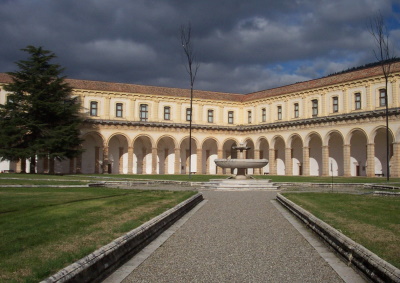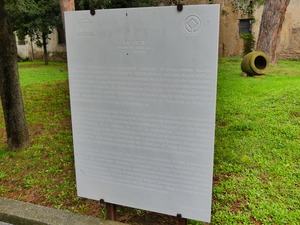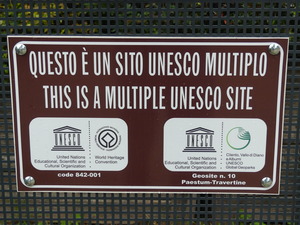Cilento and Vallo di Diano

Cilento and Vallo di Diano National Park with the Archeological Sites of Paestum and Velia, and the Certosa di Padula comprises a cultural landscape that played an important role in Mediterranean trade, culture and politics.
The area has blossomed since prehistoric times when communication routes were established along the crests of its mountain ranges. Greek colonists left their mark in the form of the city of Poseidonia (Paestum), as did the Phocaeans with Elea (Velia). In the Middle Ages, feudal castles and religious buildings were added along the routes.
Community Perspective: This is a large area, best covered by car in a day or two. Paestum is its most outstanding component.
Map of Cilento and Vallo di Diano
Load mapCommunity Reviews
Nan

In the southern part of Italy, several cities and present day world heritage sites owe their founding to Greek colonists: Naples, Siracusa, and Agrigento are a few examples. Another is Paestum and the Vallo di Diano, situated 100km south of Naples. The overall area was also referred to as Magna Graecia and had Greek speakers well into the Middle Ages where it was still part of the Byzantine Empire.
Of the listed "Greeks in Italy" sites, Paestum is most like Agrigento. Both boast many great temple ruins. The main difference I would see is that Agrigento has the more stunning scenery with the temples located on hills overlooking the Mediterranean. The other noticeable difference is that different stones were used for the construction. The orange/brown/golden stones of Agrigento are just a site to behold.
I have to admit that I only visited Paestum and that the site contains more components. Most prominently, the site also includes a medieval monastery as this tries to cover to full time range of Greek settlement in the area. Still, Paestum is the jewel of the site and I would question the decision to include the larger area.
Getting There
Paestum has it's own train station connecting you to Salerno (north) and Reggio di Calabria (south). You can also connect eastwards and travel on to Taranto.
From the train station it's a short walk to the site. The first structures you will see are the massive walls running around the former town. It also gave me a good feeling for the scope of the site.
While You Are There
From Salerno, you can visit the Costiera Amalfatina. You can also travel on to Pompei and Naples. Salerno also boasts yet another fine Norman Duomo.
Note
Our GPS coordinates are misleading. They group several spots into a National Park and do not point to Paestum proper which is significantly further North.
Clyde

I visited this WHS in November 2018 staying overnight in Paestum. The long opening hours even in Autumn mean that you can time your visit in a way that it gets dark by the time you exit the archaeological site of Paestum and the three main temples are lit up (top left and bottom right photos). You can also revisit on the same day if you stay overnight and if you love buffalo mozzarella cheese and mozzarella in general you'll have a feast when in the area.
The Greek temples of Paestum are really striking in size and detail and are comparable to the inscribed ones of Agrigento are other ones in Sicily (Segesta or Selinunte). Unlike, Agrigento you can still walk 'inside' the roofless temples to get a closer look at the architecture. It's incredible that these ancient buildings stand tall and mighty while the rest of the 20th century towns and cities nearby are mostly crumbling!
Apart from the largest and most impressive structures - the Temple of Neptune, the Basilica and the Temple of Ceres - there are other interesting things to see such as the heroon, the ekklesiasterion, the amphitheatre and also the high city walls which are one of the best preserved defensive walls in Magna Graecia.
The museum is really worth visiting and included with the entrance ticket. Just in front of it is a white marble UNESCO plaque on the Paestum part of this WHS which is quite easy to miss. Inside, among the rich finds from the archaeological site, the highlight is definitely the Tomb of the Diver (top right and bottom left photos) which in a way reminded me of the similarly colourful Etruscan tombs of Tarquinia. Other interesting artefacts worth mentioning are the stone metopes, the painted amphorae and the colourful painted terracotta features from the temples.
If you have more time to spend, you can also buy the combined ticket to visit the Velia archaeological site, mostly for its interesting mosaics where there is another UNESCO plaque for this site and drive further south to the monastery of Padula, where there is another UNESCO plaque for Cilento (at Castellabate). I think that these other locations add nothing to the inscription of the outstanding Paestum and are quite confusing as a far-fetched attempt to portray the continuous cultural landscape of Cilento and Vallo di Diano.
Allison Vies
Switzerland/Peru - 04-Jan-15 -
Paestum is the most underrated place I visited so far on my various trips to WHS. The three temples, especially the Apollo temple, are outstanding. No other Greek or Roman temple I saw so far can match them. Paestum together with Velia would deserve a separate WHS instead of being tucked together with the rather unspectacular villages and places that are included in the same world heritage site.
John booth

This site covers a huge area, including a wealth of coastal, rural and mountain scenery. Besides this I took trains to find the ancient Greek enclave of Velia (near Ascea station) with its mosaics. I then returned to Paestum (which has its own station) to see the statuesque temples of Athena, Neptune and Hera, all reminiscent of Athens.
Trenitalia runs a bus service from Battipaglia down the Vallo di Diano to Padula which I took to visit the huge San Lorenzo monastery.
Els Slots

From my hotel in Paestum, I explored this rather large area in two stages. On the first day, I visited the archaeological remains in Paestum itself. The ancient Greek buildings are in unbelievably good condition. They are the best examples I've ever seen, they may even be the best around in what's left of Ancient Greece. The local museum is also worthwhile, especially to see the painted coffins like the Tomb of the Diver (as old as 480 BC).
Two days later I got back in the car and crisscrossed the valleys. I had some trouble finding the places I wanted to see (that happens quite often), so I spent more time behind the wheel than I had hoped for. But I did reach ancient Elea, where the round Porta Rosa gate overlooks its surroundings like a medieval tower.
In Padula, on the other side of the valley, the San Lorenzo charterhouse is a mighty building. It shows a far more recent episode in Cilento's history: the design is mainly Baroque. The city of Padula itself is strategically built on a hilltop, which you see quite often in this region. Roccagloriosa and Roccadaspide are two other good examples of these medieval building tactics.
Community Rating
- : Tarquinio_Superbo Tamara Ratz AndreaTLV David Berlanda Damientournay Yevhen Ivanovych
- : Jonas Hagung SirLoydd Thibault Magnien Paolo ZaK
- : Janis Craig Harder Alexander Lehmann Daniel C-Hazard Riccardo Quaranta Ian Cade Doubanjiang Mihai Dascalu MaxHeAnouBen João Aender Viaje al Patrimonio Marcel staron Cezar Grozavu Aspasia Xiquinho Silva Christoph
- : Philipp Peterer Wojciech Fedoruk Philipp Leu Voyager HaraldOest Jezza Luboang Argo Martina Rúčková WILLIAM RICH Purrfect Els Slots
- : Randi Thomsen GeorgeIng61 Clyde Awestix Lichia Csaba Nováczky Shandos Cleaver Zoë Sheng Dorejd Lucio Gorla Nan Hubert Peter Lööv JoStof Paola Laura Lukemarshall Juha Sjoeblom
- : Svein Elias Stanislaw Warwas Roman Raab Deffra
- : Joyce van Soest
Site Info
Site History
1998 Revision
Derived from the former TWHS Paestum, Posidonia and Certosa di Padula
1998 Inscribed
Site Links
Unesco Website
Official Website
Related
In the News
Connections
The site has 37 connections
Art and Architecture
Constructions
Ecology
Geography
History
Human Activity
Individual People
Religion and Belief
Science and Technology
Timeline
Trivia
WHS Hotspots
WHS on Other Lists
World Heritage Process
Visitors
206 Community Members have visited.
The Plaque
 (photo by Clyde)
(photo by Clyde) (photo by Clyde)
(photo by Clyde)